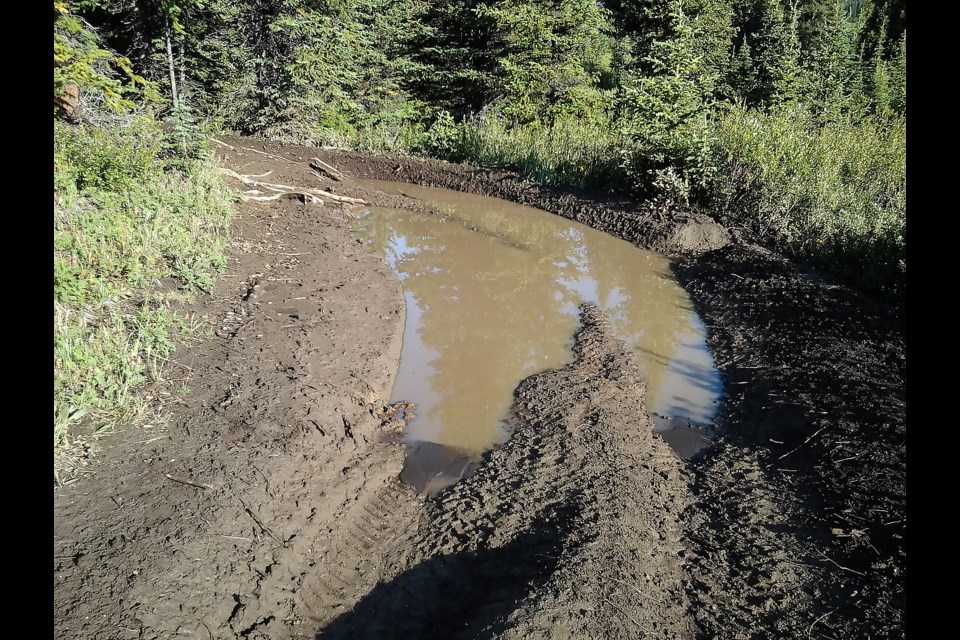BANFF – The Alberta Wilderness Association (AWA) is calling for greater enforcement, stiffer fines and more restrictions on off-highway vehicle use in the Bighorn Backcountry adjacent to Banff and Jasper national parks to safeguard against ongoing environmental degradation.
A new report, which was released by AWA on Monday (July 31), concluded current access management in the Bighorn is inadequate and enforcement of regulations is not sufficient enough to reduce the amount of illegal off-highway vehicle (OHV) activity on trails.
On top of that, AWA officials say the current levels of recreational OHV use, leading to trail damage, including rutting, widening, erosion, braiding, and secondary trails, are causing severe environmental degradation.
“With an increasing population in Alberta, these problems will likely grow in the future,” said Devon Earl, a conservation specialist for AWA.
“These steps are necessary to prevent further and possibly irreversible damage to this important wilderness area.”
The Bighorn Backcountry, also known as Bighorn Wildland, is an area of about 5,000 square kilometres just east of Banff and Jasper national parks, extending from the Red Deer River in the south to the Brazeau River in the north.
The region includes important headwaters habitat, with almost 90 per cent of the water flow of the North Saskatchewan River originating in the region, primarily supplied by a network of gravel-bed river floodplains.
These floodplains support critical habitat for native fish, bird diversity, aquatic insects, amphibians, and various flora communities, and are also considered important for wildlife migratory corridors.
Slated for protection by the provincial government in 1986 and again in 2019, but both times these designations were never enacted, the Bighorn was first identified as a provincially significant wilderness area in the 1970s.
In 2002, the Bighorn was placed under new access management regulations, which are now called Public Land Use Zones (PLUZs), allowing the province to open up OHV activity on designated trails where these activities were previously banned.
At the time, the largest OHV trail system was created in the Hummingbird area of the Upper Clearwater and Ram rivers, which contains a network of eight trails located within the Prime Protection Zone.
As a result of these changes about 20 years ago, AWA carried out research and monitoring between 2004 and 2019 to determine the extent of the damage to the trails and the surrounding landscape caused by OHVs.
During this time, AWA has produced three interim reports, but this is the final comprehensive report summarizing the three earlier studies and presenting the findings and results throughout the entire 15-year study period.
Key findings in the study identified trail damage has increased significantly, with 344 observations of trail damage, including rutting, widening, erosion, braiding, and secondary trails recorded.
In addition, the report found damage was exacerbated during extremely wet conditions, and the ad hoc reconstruction and rebuilding did little to repair the damaged sites, and in many cases, appeared to have caused additional damage.
Water bodies were also not adequately protected.
AWA documented 46 instances where a trail crossed a stream or other water body throughout the trail network in 2017, the last year of monitoring. Only 13 per cent of these had a bridge or some other form of crossing structure in place.
“Off-highway vehicle use in the Bighorn Backcountry damages soil and vegetation, reduces water quality in the headwaters of the North Saskatchewan River, and destroys and degrades fish habitat,” said Earl.
The report indicated illegal use of trails was detected consistently.
AWA’s observations show although there is some reduction in OHV traffic when a trail is closed and most OHV users respected the closures, many however, regularly broke the rules.
That included still using trails even when closed or when out of the designated season and regularly driving in areas that were not designated trails.
“It is clear to us that education of OHV drivers on designated trail rules is not effective, and the enforcement of those rules is not adequate,” said Earl.
Some of the key recommendations also include a call to have water quality and fisheries issues addressed by improving water crossings on designated trails through the construction of bridges for permanent streams and hardened fords for ephemeral streams.
The organization wants all non-designated trails blocked off and signed at the junction, for the province to respond to changing conditions like closing flooded trails, and enforcement of a three-metre designated trail width.
Heinz Unger, a professional civil engineer, has voluntarily done monitoring for AWA for 15 years.
“I have seen the increasingly severe degradation of the Canary and Hummingbird Creeks’ stream beds and beautiful wet meadows because of the improper location of the designated OHV trails,” he said.
The Bighorn Backcountry is popular with not only motorized uses like OHV and snowmobiles, but also for camping, hiking, fishing, hunting and cycling.
A spokesperson for Alberta Forestry and Parks says the provincial government is committed to protecting the Bighorn Backcountry while continuing to offer outdoor recreation opportunities.
“In recent years, the area has seen a substantial increase in visitation, which has put pressure on the landscape,” said Bridget Burgess-Ferrari, the ministry’s communications advisor.
“The Ministry of Forestry and Parks is managing this increase in visitation in a sustainable and safe manner by focusing on public education and investing in trails and projects in the area.”
Burgess-Ferrari said the area is proactively patrolled by conservation officers who educate and enforce the regulations to keep the area safe.
“Conservation officers have the authority to implement closures in response to environmental or safety concerns,” she said.
Public safety incidents, illegal activity and enforcement concerns, including improper use of OHVs and illegal trails, can be reported by calling 310-LAND (5263).
The Alberta Off-Highway Vehicle Association did not get back to the Outlook with comment by publication.



